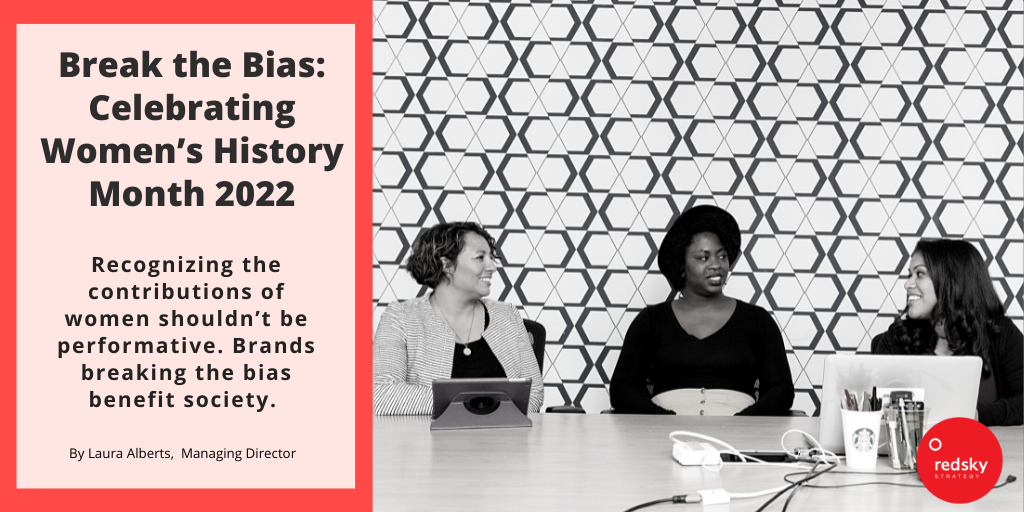News
Break the Bias: Celebrating Women’s History Month 2022

Image Credit: https://unsplash.com/photos/0hGVZGBnW7U
March 8th was International Women’s Day, a global celebration of the economic, political, and social achievements of women dating back to 1911. This year, the annual celebration theme is #BreaktheBias. Rightfully so considering that, despite some of the significant strides women’s rights have made in the last century, there are still many biases to be broken and much work to be done.
March is also Women’s History Month. However, merely or performatively acknowledging the power and contributions of women for one day or a whole month isn’t enough to bridge the gender gap continuing to plague our society.
Women in the U.S. earn 82 cents for every dollar earned by their male counterparts, and this pay gap is worse for women of color. Black and Latina women with a bachelor’s degree have the largest gap (65%). The gap continues to exist because of discrimination and bias, not because women work fewer hours or less consistently than men.
The same principle applies to assuming what women find important. Women’s stories are often mummed by the dominant narrative. Consider the Bechdel Test, which is a measure of the representation of women in fiction. It asks whether a work features at least two women who talk to each other about something other than a man. The requirement that the two women must be named is sometimes added. More than half of all films meet these three criteria.
Note that the Bechdel Test is a floor, not a ceiling — it’s the minimum for representation. The Russo Test, inspired by Bechdel, operates similarly to consider queer representation in films. In 2012, it found that only 14 out of 101 characters from major studio releases identified as LGBTQ+. If at least half of films fail these tests, consider what this says about the diversity of representation.
Equality and Overcoming Bias
The above are just a few examples representing a much larger issue at play: Gender bias continuing to belittle women in (and out) the workplace.
There is the motherhood penalty, referring to the phenomenon of how women who have children are often paid less than their childless peers. Research has shown that women with children earn less than childless women, and mothers with more than one child suffer a larger penalty.
On the other hand, men earn more (over 6%) when they have children. The gap between men’s and women’s earnings is much larger for mothers with one or more children than for fathers with one or more children. This shows that it’s specifically motherhood — not parenthood — affecting wages in the U.S.
Conscious and unconscious bias is a big part of bringing attention to International Women’s Day and Women’s History Month — and that includes calling it out when we see it.
Many brands and companies like to preach the importance of womanhood and female empowerment this time of year. Unfortunately, too many are guilty of the very practices they’re speaking out against — something the Gender Pay Gap Bot Twitter account recently decided to bring attention to.
In this organisation, women’s median hourly pay is 23.5% lower than men’s. https://t.co/tG2DrnUxh9
— Gender Pay Gap Bot (@PayGapApp) March 11, 2022
The bot, built last year by social media manager Francesca Lawson and software developer Ali Fensomeha, puts British companies on blast by quote-tweeting their International Women’s Day posts with the data revealing their own gender pay gaps:
A quick scroll through the profile showcases how severe some of the median pay gaps are (and how many companies have them).
After years of little progress toward pay equity, more states, such as New York, are passing pay transparency laws that eliminate the secrecy around salaries, which could be a powerful tool for eliminating the gender pay gap. However, it’s one thing to record the pay data among company employees and another to actually act on any notable discrepancies.
The ‘Pink Tax’ and Other Marketing Missteps
Women face inequality both as professionals and consumers. When it comes to marketing, women bring a perspective that is often slighted or overlooked.
Take the startup behind the Pinky Glove, a product for tampon removal created and invested in by men. They designed it to “create a “safe feeling” for women and offer something that is “appealing and stylish”, only it aims to solve an issue that doesn’t really exist.
As Smart Company points out, this is an example of “creating another ‘pink tax’ — where women pay the additional cost of ‘feminine’ marketing and colors for a product that is often already available or, worse, that they don’t need at all.”
Too often we fail to give women a voice in their own narratives, and instead, silence them with patriarchal notions of what is acceptable or desirable and outdated assumptions of femininity.
How can brands show they’re truly celebrating women?
A good place to start is diversifying their own companies. According to the U.S. Census Bureau, women make up roughly half of the U.S. population. Yet women represent less than 25% of corporate boards and leadership positions, and about 28% of STEM jobs.
The numbers alone tell us that there is still a long way to go before we see real progress in gender parity in the workplace, let alone the rest of society. And this isn’t taking into account women with other marginalized identities, such as BIPOC and/or LGBTQ+ women, who are even more grossly underrepresented in corporate leadership roles.
There are some brands excelling at diversifying their workforces:
- Sodexo’s staff is made up of 55% women, with women accounting for 58% of its board of directors
- HubSpot runs a Women@HubSpot group to specifically support the professional development of women in tech
- Nike launched an “Until We All Win” campaign to highlight the stories of indigenous peoples and LGBTQIA+ athletes
Some steps that brands can take to help bridge the gender pay gap and overcome bias include:
- Implementing inclusive and intentional hiring practices
- Uplifting and emphasizing women’s and BIPOC women’s businesses
- Being transparent about compensation
- Providing an equitable pathway to ownership
Diversity is key for brands to achieve their business goals and make meaningful strides toward gender parity in our country, but it’s not an easy task. It requires sustained effort. The opportunity to highlight the success of women and their critical role in the workforce and in society is important – and almost a requirement – to continue the elevation of all women as equals to men.
Interested in understanding and representing your female consumers in more meaningful ways and creating new pathways of growth for your company? At RedSky Strategy, we can provide a unique perspective called HumanSight™ to illuminate the best way forward.
